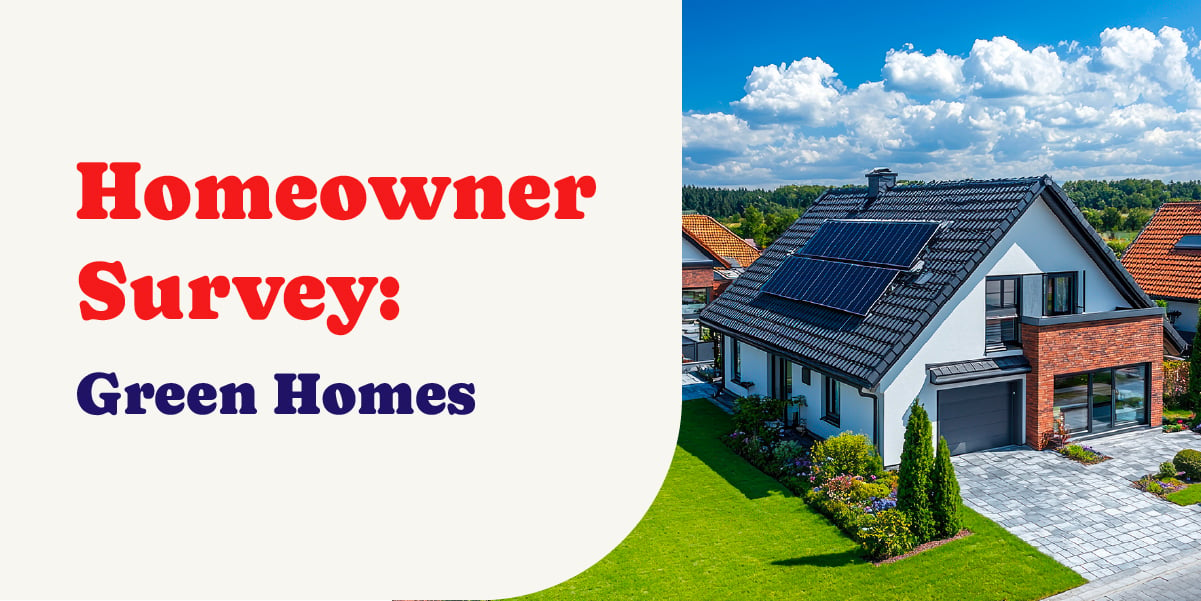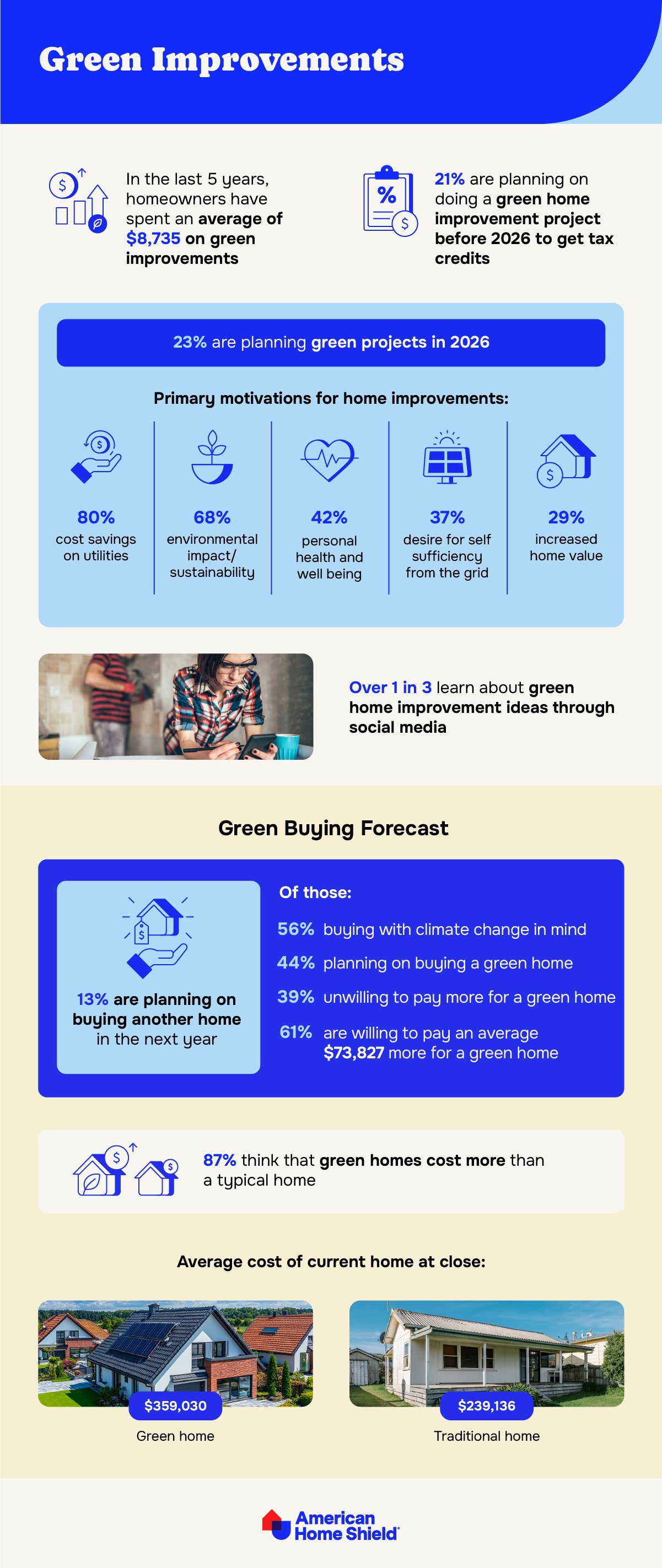The Climate Cost of Homeownership: Why Green Homes Are Rising in Value
As utility bills skyrocket and every summer seems to be the hottest summer on record, green homes – eco-friendly homes that minimize energy usage and reduce strain on the grid – are growing in popularity.They come with a catch, however– like all housing, limited supply, and the additional costs of greening infrastructure can be prohibitive.
How do homeowners today feel about green homes, or even making their current homes greener?

Methodology
In order to find out, we decided to survey 1,004 homeowners nationwide in late August 2025 about their views on green homes, climate-friendly improvements, and how climate change was affecting their lives today. 50% were women, 49% men, and 1% were nonbinary or did not disclose, with ages ranging 20-75 and an average age of 48. 58% lived in the suburbs, 25% in rural locations, and 17% lived in urban settings.
Key Findings
- Prospective homebuyers are willing to pay an average $73,827 more for a green home
- 77% of homeowners think green homes will retain value more than other homes
- 1 in 5 are making green improvements before IRA tax credits end in 2026
- 2 in 3 homeowners are worried about how climate change will affect their bills
- 62% believe all new homes should be green homes
- 82% believe the government should encourage green home construction
- Most homeowners are motivated by potential savings to green their home
- 91% of green homeowners say their investment was worth it
Inflation Reduction Act Tax Credits: 1 in 5 Racing Against Time

Tax incentives are emerging as one of the most effective tools in accelerating the green home movement. About one in five homeowners (21%) plans to make eco-friendly improvements before the end of 2025 to take advantage of IRA tax credits. Those credits were slated to extend further, into 2032, but the One Big Beautiful Bill, signed into law by President Trump on July 4, 2025, opted to end them early, resulting in a scramble to make improvements while the incentive was still there.
Of those with plans extending into 2026, many have already altered their timelines or scope. One in ten canceled projects entirely after the early elimination of these credits. More than a third reduced the scope of their upgrades without the expected tax credits. A third are moving forward anyway, while over one in five weren’t aware the credits existed at all.
How much of a tax break would convince the broader population to invest in green infrastructure? On average, homeowners say a $17,500 tax break would be enough to push them into making a green investment. This speaks to how much cost can be a barrier to making critical green improvements.
Climate Change: Higher Bills, Greener Homes

For many homeowners, climate change is not an abstract concept, but can be felt in every utility bill. Nearly two in three now fear the impact of climate change on their bills, while over a third say their quality of life has already been compromised. Top examples include higher utility bills, hotter homes, and higher storm intensity.
The physical and financial realities of a warming world are hitting close to home—literally. More than three quarters of homeowners (77%) believe green homes will retain value better than traditional ones as climate conditions worsen. Support for government involvement is equally strong, with 82 percent calling for policies that encourage green construction. Sixty-two percent go even further, saying all newly built homes should be designed with green features from the ground up.
Top Motivators for Eco-Friendly Home Improvement
- 79% long term utility savings
- 78% significant tax credits
- 38% increased availability of homes and contractors
- 24% easy access to information / resources
When asked to rank the most important aspects of a green home, respondents prioritized cost savings first, followed by environmental benefits and utility independence. Fewer, though still notable, saw protection from climate-related disasters as a key factor.
Homeowners Investing Nearly $9,000 on Green Upgrades

In just the past five years, homeowners have spent an average of $8,735 on green upgrades. From installing energy-efficient HVAC units and appliances to green roofs, solar panels, and more, there is an environmentally friendly option at nearly any price point.
The momentum is continuing: 21 percent plan to take on a green improvement before the end of 2025, and nearly one in four are already planning for 2026. Cost savings remain the top driver, but environmental impact, personal health, and resilience against power outages are also gaining traction. For many, these upgrades are as much about peace of mind as they are about economics.
Where are homeowners getting their green inspiration? Online: more than a third of homeowners say they’ve discovered green home improvement ideas via social platforms.
Prospective Homeowners Willing to Pay Nearly $74,000 More for a Green Home

The real estate market is also shifting. Thirteen percent of homeowners plan to buy a new home within the next year. Of those, over half are factoring in climate change, and nearly half plan to buy a green home. Among this group, willingness to pay a premium is common. The average buyer says they’d spend nearly $74,000 more on a green home. This matches market data showing an average purchase price of $359,000 for green homes, compared to just under $240,000 for traditional ones.
Despite the cost difference, value perception remains strong. Nearly nine in ten believe green homes are more expensive, but 91 percent of current green homeowners say the investment has been worth it.
12% of Green Homeowners Don’t Pay Utilities
Currently, just 26 percent of homeowners say they live in a green home. Of that group, 77 percent made improvements themselves rather than buying green from the start. Energy-efficient appliances are the most common feature, present in more than two thirds of these homes. Over half have solar panels, and many also incorporate green landscaping, rain barrels, or architectural certifications like LEED.
These investments yield real returns. About 12 percent of green homeowners report paying little or nothing in utility bills, while nearly a quarter acknowledge having paid a premium for their eco-friendly features.
Cost over Climate: 57% of Homeowners Cite Cost as Main Barrier to Green Ownership
Despite broad interest, more than seven in ten homeowners still live in traditional homes. Among them, nearly two-thirds wish they lived in a greener home. The main barrier is cost—cited by 57 percent—followed by attachment to traditional designs and a lack of awareness around benefits. Education and affordability continue to be major gaps.
Even so, aspirations are changing. Nearly two-thirds of homeowners say they’d rather live in a smaller green home than a larger, less sustainable one.
As climate change shifts priorities across the U.S. and homeowners face climbing temperatures and subsequent utility bills, green homes will become an increasingly appealing option for most. While cost and availability are the main barriers to prospective buyers, there’s openness to government support for climate-friendly initiatives and downright enthusiasm for cost incentives to go green.
Frequently Asked Questions about Inflation Reduction Act Tax Credits
1. Where can I find official guidance on these tax credits?
For complete details and requirements, visit:
2. Which HVAC systems are eligible for the tax credit?
It depends on your system’s type and efficiency rating:
- Air-Source Heat Pumps: Up to $2,000, ENERGY STAR® certified
Central A/C Units: Up to $600 per unit, specific efficiency ratings required - Gas & Oil Furnaces: Up to $600 per unit, must meet ENERGY STAR® standards
3. How can I confirm my system’s eligibility?
Eligibility depends on the model, efficiency rating, and ENERGY STAR® certification. You can check your system’s eligibility here before purchasing.
AHS assumes no responsibility, and specifically disclaims all liability, for your use of any and all information contained herein.


